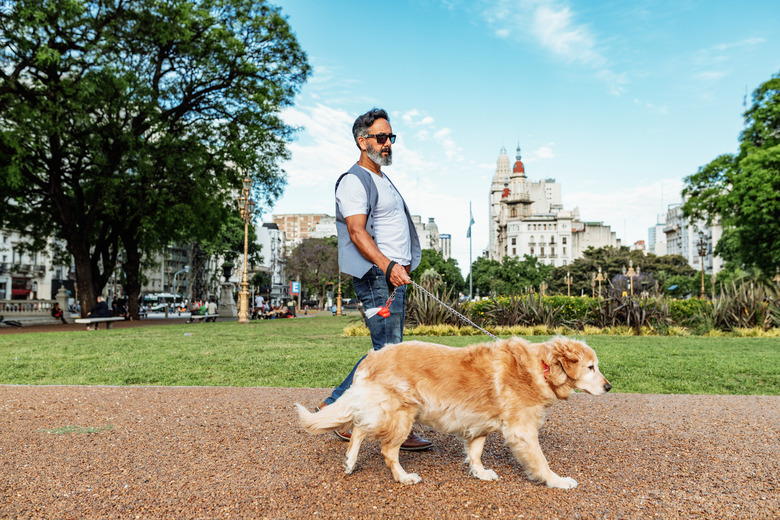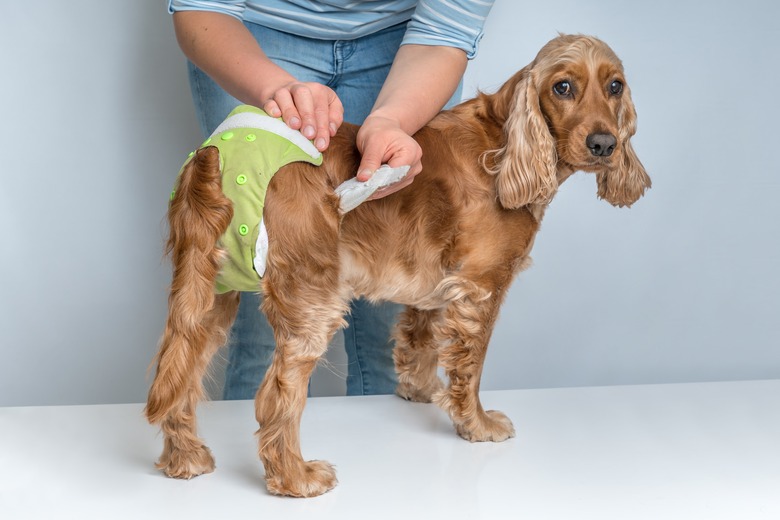Dog In Heat Symptoms
If you're the pet parent of an unspayed female dog, your pet's "period," or heat cycle, is something you will need to understand and prepare for. During this time, your dog's hormone levels will be in flux, and your pet will exhibit some telltale physical and behavioral signs that she is in heat. Knowing these dog in heat symptoms will help you recognize when it happens. If you have further questions regarding your dog's estrous cycle, you should consult your veterinarian.
What is the dog heat cycle?
What is the dog heat cycle?
A dog's heat cycle is her reproductive cycle. It comprises three stages, including proestrus, estrus, and diestrus. Estrus is the period in which a dog is receptive to mating with male dogs and can become pregnant. One full cycle usually lasts from 14 to 24 days. Larger breed dogs and giant breeds typically go into their first heat at a later age than small dogs go. Larger dogs can be 18 months to 2 years old.
At what age do female dogs have their first heat?
At what age do female dogs have their first heat?
The majority of female dogs who are not spayed will reach sexual maturity and go into their first heat cycle at around 8-11 months of age. However, smaller breeds can have their first estrous cycle as early as 6-7 months old, while large breeds can go into heat for the first time as late as 1 year old. To avoid accidental pregnancy, consider neutering or spaying your dog. this not only helps prevent unwanted litters, it also has some health benefits that last throughout life. Don't let your unspayed dog who is in heat off-leash during this time, as male dogs that are nearby can sense her and will try to get to her.
How often are dogs in heat?
How often are dogs in heat?
Most dogs will experience two estrous cycles per year. The rest of the year, the time when your dog is not in heat, is called anestrus. During anestrus, a female dog will not display signs of hormonal changes, and she will not be receptive to mating.
6 signs your dog is in heat
6 signs your dog is in heat
Knowing what to look for can help you spot estrus early. Watch your pet closely for common dog in heat symptoms, from subtle shifts in mood to more obvious physical changes. Keep in mind that a dog's first heat can be "silent," meaning she might not display any noticeable signs of heat.
Behavioral Changes
During the first week of heat, your dog's behavior and personality might seem different than usual. She might be unusually clingy, grumpy, or nervous. However, this is not universal. Some dogs act completely different, while others do not have any pronounced mood changes.
Appetite Changes
Dogs often experience a decreased appetite during their first week of heat. Less commonly, a dog in estrus might have an increased appetite.
Vulva swelling
Your dog's genital area might appear enlarged when she is in heat. This symptom varies from dog to dog; some canines have a very noticeable swollen vulva, while others might not be obvious. The dog also might tuck her tail between her legs or lick the area excessively.
Increased urination
Some dogs urinate more often when they are in heat, so you may notice her requesting to go out more often. Much like humans, this is because the dog's uterus swells during estrus, putting pressure on the bladder.
Tail waving
After the vulva swelling decreases, a dog in heat will begin waving, or flagging, her tail more often than usual. This is an attempt to disperse her pheromones in order to catch the attention of a male mate.
Bloody discharge
A dog in heat will expel a bloody discharge from the vagina for two to three weeks. The discharge will grow heavier as time goes on, eventually going from a bright red to a pinkish-tan color before tapering off as the estrous cycle ends. It is possible to use doggy diapers when your female dog is in heat. These are soft and washable diapers that can prevent the staining and licking that can come along with the vaginal bleeding stage of the estrus cycle.
At what age should I spay my dog?
At what age should I spay my dog?
Most dogs can safely be spayed at about 6 months of age. Having your female dog spayed can not only eliminate heat symptoms and the chances of unwanted pregnancy but it can also have health benefits. Spayed dogs have zero risk of pyometra (a serious and sometimes fatal uterine infection), and the odds of certain cancers, like mammary carcinoma, are dramatically decreased. Your veterinarian can advise you on the proper time to have your pet spayed.
The bottom line
The bottom line
Unspayed female dogs will have their first estrous cycle, or "heat," when they are 7 months to 1 year of age depending on size and dog breed. Most dogs have two estrous cycles per year, with each cycle lasting 14 to 21 days. Dog in heat symptoms include behavioral or mood changes, frequent urination, appetite changes, swelling of the vulva, and bloody vaginal discharge. Spaying your dog can eliminate all of these symptoms, and it can have several health benefits for your pet. Speak to your DVM about your dog's estrous cycle as well as the best time to have your pet spayed.


